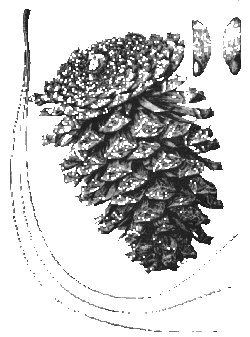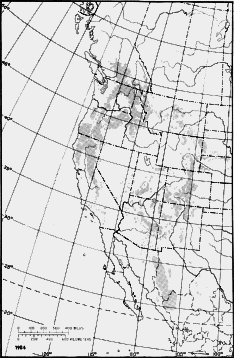Ponderosa Pine (Pinus ponderosa)
The ponderosa pine, also known as the yellow pine, is one of the most widely distributed tree species in the West, growing from southern Canada into Mexico, and from Nebraska and Oklahoma all the way to the Pacific Coast.
The largest recorded diameter was over 8 1/2 feet. The tallest tree was 232 feet, and the oldest tree was 600 years.

Ponderosa Pine Identification:
- Needles are 5 to 10 inches long and in bundles of three, forming tufts at the end of each branch.
- Cones are oval, 3 to 6 inches long and 2 to 4 inches in diameter, with outwardly curved spines that make them prickly to handle.
- Bark is dark brown and rough textured in young trees and orange-brown with distinctive large plates in mature trees
Range
In California ponderosa pine is found in the Coast Range, Klamath, Cascades, and throughout the Sierra Nevada, all the way down to San Diego. Its elevation ranges from 500 to 3,500 feet in Northern California and 5,300 to 7,300 feet in Southern California.
Climate

Summer soil moisture most often determines whether ponderosa pine will grow in a particular area. The west slope of the northern Sierra Nevada, which receives an average rainfall of 69 inches, may be the wettest area in its natural range supporting ponderosa pine in large numbers.
Ponderosa pine grows on a wide variety of soils, including those of igneous, metamorphic, and sedimentary parent materials. Its distribution on drier sites depends on soil moisture, which depends on soil texture and depth. The species grows better on soils which are medium in texture and, hence, release their moisture to plants readily. Because ponderosa pine needs less nitrogen and phosphorus to grow its needles, the tree can grow well in soils which are not fertile enough for other species.
Ponderosa pine regenerates by seed, with cones maturing in a two-year cycle. The tree flowers from April to June of the first year, and cones mature and shed seeds in August and September of the second year. Seeds are relatively small (7,000 to 23,000 in one pound) and fall only about 100 feet from the parent tree.
On the west side of the Sierra Nevada, normal seed crops are borne on average every 2 to 3 years, while very heavy cone crops occur an average of 8 years apart. Trees may start to bear cones as early as seven years old and continue for 350 years, and those over 25 inches in diameter are the best producers. Cones may bear up to 70 seeds each. Seeds are damaged or eaten by insects, birds, and small mammals such as mice, chipmunks, and tree squirrels.
Young ponderosa pine seedlings are threatened by moisture stress. Competition from shrubs can reduce their height and diameter growth. Young seedlings can withstand higher temperatures than most associates including Douglas-fir, white fir, and sugar pine but are more easily damaged from frost (23° F) than other trees.
One reason ponderosa pine is able to grow on dry sites is its vigorous rooting system. Seedlings put out a taproot which can grow up to 20 inches or more in the first two months, in well-watered soils. Mature trees have roots down to 6 feet in porous soils and may extend laterally 150 feet in open stands. In denser stands, roots are generally as wide as the tree's crown.
At lower elevations, ponderosa pine grows in relatively pure stands while higher up it grows mixed with other conifer species. In the Coast Range, it grows as a component of the mixed-evergreen forest type, rarely in pure stands.
Fire has a profound effect on ponderosa pine distribution. Although seedlings are killed by fire, larger trees possess thick bark, which protects them from fire damage. Fire resistance is also fostered by the species' characteristically open crown and tendency to self-prune limbs when mature, which reduces fuel ladders.
Saplings and large pines are more fire resistant than many true firs and Douglas-fir. Pines can survive and grow after fires even when half of their crowns have been scorched.
In the past, frequent low-intensity fires kept many pine forests open and park-like and helped to maintain ponderosa pine in areas where more shade-tolerant species would have predominated. Fire suppression over the last 100 years has allowed unnaturally high buildup of fuels and allowed ponderosa pine dominated stands to be crowded with white fir. Prescribed burning has been used in some areas to restore species balance.
Ponderosa pine is shade intolerant. When underneath a light overstory which casts 50% shade, its growth slows by half from full sun conditions. In shade, ponderosa pine grows at half the rate of associated species including Douglas-fir, sugar pine, white fir, and incense cedar.
Because of this intolerance to shade, ponderosa pine often grows in even-aged patches. It is vulnerable to overcrowding but may respond to thinning between ages 70 to 100. A growth response has even been noted at age 200.
On productive sites, trees can reach 26 inches in diameter in 30 years (8.7 inches/decade). Trees with a diameter of 30 to 50 inches and height of 90 to 130 feet are common throughout its range.
Competition from other plants, including neighboring trees and shrubs can reduce diameter growth markedly, especially on droughty soils. Trees grown with intense competition are also subject to more insect damage.
Historically, nearly every even-aged and uneven-aged silvicultural system has been applied to ponderosa pine management, with variable levels of success.
|
Tree Species Associated With Ponderosa Pine in California | |
|---|---|
|
California white fir |
(Abies concolor) |
|
incense-cedar |
(Libocedrus decurrens) |
|
Jeffrey pine |
(Pinus jeffreyi) |
|
sugar pine |
(Pinus lambertiana) |
|
Douglas-fir |
(Pseudotsuga menziesii) |
|
western juniper |
(Juniperus occidentalis) |
|
California black oak |
(Quercus kellogii) |
|
Shrubs Associated With Ponderosa Pine in California | |
|---|---|
|
manzanita |
(Arctostaphylos spp.) |
|
buck brush, deerbrush, snowbrush |
(Ceanothus spp.) |
|
bitterbrush |
(Purshia spp.) |
|
sagebrush |
(Artemisia spp.) |
|
chokecherry, bittercherry |
(Prunus spp.) |
|
spiraea |
(Spiraea spp.) |
|
snowberry, |
(Symphoricarpos spp.) |
|
ninebark |
(Physocarpus spp.) |
|
Oregon grape |
(Berberis spp.) |
Damaging Agents
Approximately 200 insect species affect ponderosa pine from its cone stage to maturity. Pine beetles (Dendroctonus spp.) cause tree death by transmitting blue stain fungus to the tree and by consumption of the phloem by their larvae. Western pine beetle (Dendroctonus brevicomis) is a common cause of death for older trees and drought stressed trees, as well as for healthy, vigorous trees during epidemics.
Bark beetles (Ips spp.) are naturally present in all stands. Harvesting methods which leave large amounts of logging slash can allow their populations to explode and kill vigorous trees up to 26 inches in diameter. Parasites, root diseases, rusts, trunk decays, and needle and twig blights also cause significant damage. The most widespread parasite is dwarf mistletoe which causes branch and stem deformation.
|
Insects That Damage Ponderosa Pine | ||
|---|---|---|
|
Common Name |
Scientific Name |
Impact |
|
Western pine beetle |
(Dendroctonus brevicomis) |
Kills older trees and healthy trees during epidemics |
|
(Ips spp.) |
||
|
Ponderosa pine cone beetle |
(Conophthorus ponderosae) |
Eats and destroy seeds |
|
Pine seed chalcid |
(Megastigmus albifrons) |
Eats and destroy seeds |
|
Pine tip moth |
(Rhyacionia bushnelli) |
Deforms buds and shoots on seedlings & saplings |
|
Gouty pitch midge |
(Cecidomyia piniinopis) |
Retards growth on buds and shoots |
|
Western pineshoot borer |
(Eucosma sonomana) |
Deforms buds and shoots on seedlings & saplings |
|
Pine reproduction weevil |
(Cylindrocopturus eatoni) |
Threatens slow growing plantations |
|
Budworm |
(Choristoneura lambertiana) |
Deforms buds and shoots on seedlings & saplings |
|
Pine butterfly |
(Neophasia menapia) |
Defoliators |
|
Pandora moth |
(Coloradia pandora) |
Defoliators |
|
Pine needle sheathminer |
(Zelleria haimbachi) |
Defoliators |
|
Animals That Damage Ponderosa Pine | |
|---|---|
|
Animal |
Impact |
|
Rabbits & hares |
Kill seedlings, clip shoots |
|
Pocket gophers |
Kill seedlings & saplings by |
|
Squirrels & porcupines |
Kill saplings & pole-size trees, |
|
Deer |
Browsing stunts seedling growth |
|
Sheep & cattle |
Trampling & occasional |
|
Diseases That Damage Ponderosa Pine | ||
|---|---|---|
|
Common Name |
Scientific Name |
Impact |
|
Dwarf mistletoe |
(Arceuthobium campylopodum) |
Kills trees, stunts height growth, weaken seeds |
|
Black stain root |
(Leptographium wageneri & Heterobasidion) |
Kills roots and trees of all ages,sometimes large groups of trees allowing bark beetle invasion |
|
White stringy root rot |
(Heterobasidion annosum) |
Often found in combination with bark beetle infestations |
|
Armillaria |
(Armillaria spp.) |
Have caused death in young plantations and thinned stands |
|
Heart rot |
(Phellinus pini & Dichomitus squalens) |
Loss of sound wood in commercial stands |
|
Needle cast |
(Elytroderma deformans) |
Infects host twigs, slows growth and kills trees, and leads to bark beetle infestation |
|
Blister rust |
(Cronartuim comandrae) |
Causes scattered mortality in sapling and pole stands |
|
Air pollution |
ozone |
Damages needles causing mottling and loss of needles, leading to bark beetle attack and |
Uses
Native Americans used the inner bark of ponderosa pine as food and its resin as a medicinal salve for rheumatism, backaches, and dandruff. Ponderosa pine forests today are important for timber production, livestock grazing, and recreation. Big game such as deer and elk use the forests for food and shelter as do many other wildlife species.
California is second, after Oregon, in production of ponderosa pine lumber, milling more than a billion board feet a year. Old-growth ponderosa pine produces clear, knot-free, high grade lumber, but young trees are often limby because self-pruning develops slowly, causing knotty lumber.
The mature tree's uniform grain makes it desirable when appearance rather than strength is important. The wood does not shrink and swell much after processing, making it valuable for close fitting joints in applications such as molding, doors, window frames and drawers, paneling, furniture, and other wood work. It is also used in home construction for framing, floor and roof decking, and outdoor applications when treated.
This text was largely summarized from an article originally by William W. Oliver Project Leader, Pacific Southwest Forest and Range Experiment Station, Berkeley, CA and Russell A. Ryker Principal Silviculturist (retired), Intermountain Research Station, Ogden, UT that appears in Burns, Russell M., and Barbara H. Honkala, tech. coords. 1990. Silvics of North America: 1. Conifers. Agriculture Handbook 654. U.S. Department of Agriculture, Forest Service, Washington, DC. vol. 1, 675 p.
Interested readers are referred to the original article for more detailed and technical information and references. Publication of this series was in part funded by the California Department of Forestry and Fire Protection under Contract numbers 8CA96027 and 8CA96028.
